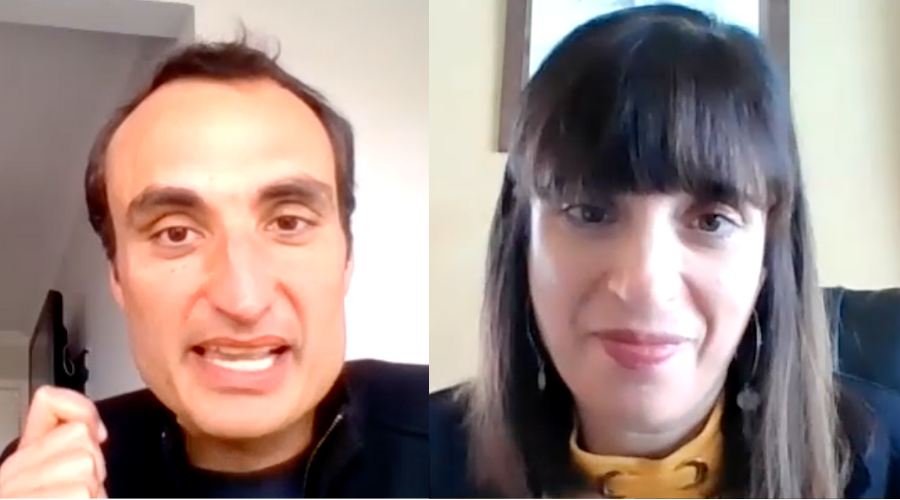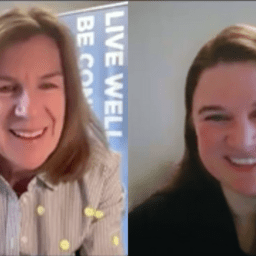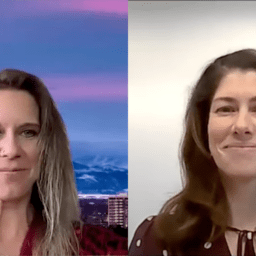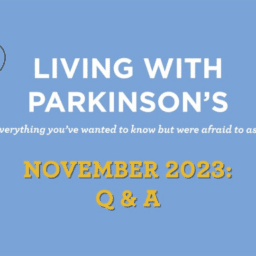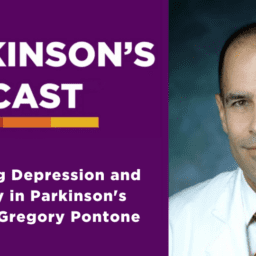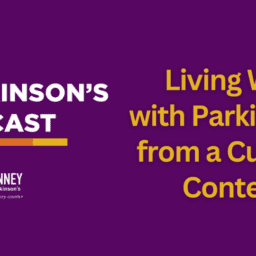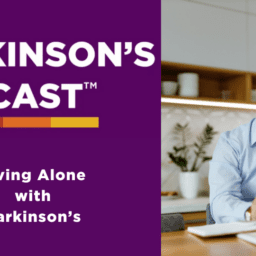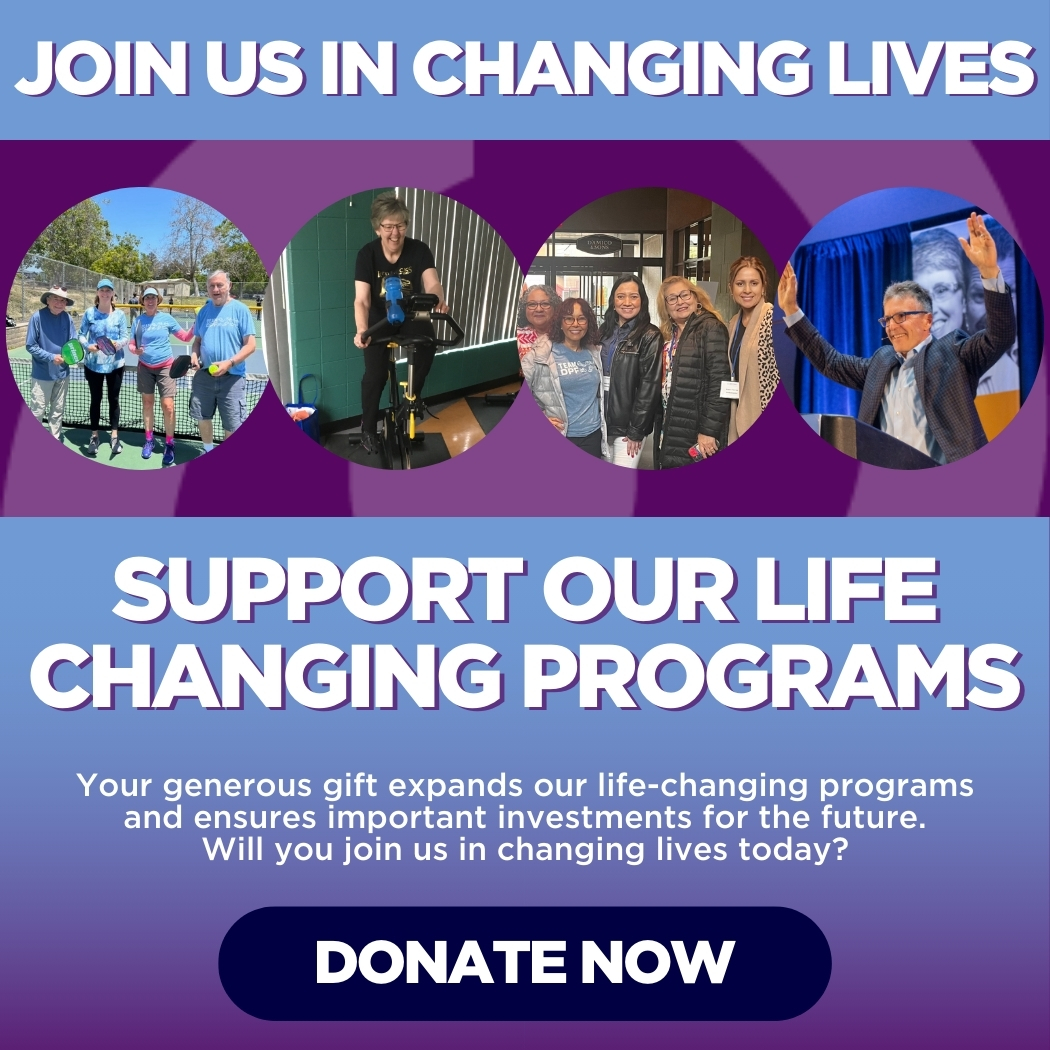Imagine if you had access to your doctor or movement disorder specialist via a computer was just a few clicks away. Or you could have an appointment via the phone in the comfort of your own living room.
Telemedicine makes that possible.
Telemedicine is the practice of healthcare in an online format. As video conferencing technology has developed and become more reliable and secure, and as COVID demanded that we stay safe at home, more physicians and specialists began offering their services through video calls in addition to or instead of in-person appointments.
During this session facilitated by Dr. Soania Mathur, panelists Dr. Roseanne Dobkin and Dr. Ray Dorsey discussed the state of telemedicine in the US, the laws that impact its use, and the efforts being made by advocates and policy makers to ensure that it’s legal, safe, and sustainable for the largest number of people. They also discussed the logistics of a telemedicine call and what to do to make sure you get the most out of your medical team during these virtual sessions.
To download the audio, click here.
You can read the transcript below. To download the transcript, click here.
Note: This is not a flawless word-for-word transcript, but it's close.
Melani Dizon (Director of Education and Research, Davis Phinney Foundation):
Hello and welcome everybody, my name is Melani Dizon. I'm the director of education and research at the Davis Phinney Foundation, and I'm super glad to have you all here today we're going to be talking about telemedicine and Parkinson's. We have Roseanne Dobkin here. She is a member of our Science Advisory Board and has done a lot of work in telemedicine field and we also have Ray Dorsey. We actually funded a study a long time ago around telemedicine and so he's been doing a lot of work in his area and we’re excited to talk to him. We also have Soania Mathur who's going to be our moderator today, and I'm going to turn it over to her in just a minute but just want to go through a couple of things real quick with you.
I have turned on Closed Captioning, so you should be seeing that on the bottom of your screen. If you do not want to see it throughout the time, there's a little icon at the bottom of your screen that says, “live transcript,” if you click the little arrow, you can say hide subtitle. So, if you don't like that showing up on your screen you can hide that. There's a little box, another icon, on the bottom that says “chat.” It would be great right now if you click that, and it should open to a little pop up on the right and just say hello. Let us know that you can hear us and see us and tell us where you're calling from so we can say hello to you.
So, if you want to send us a question, you can see the little blue box at the bottom of your chat screen and it says, “all panelists and attendees” or “all panelists.” If you just want us to see it, then you can send it through there and not the rest of the audience will see it. If you want everybody who's watching and listening to see your question, you click “all panelists and attendees,” which sometimes is really great because people can chime in and help you out. This way, people will be able to see it.
I think that's all I have. Please know that if you have to leave early, we will send you the recording of the video and the audio and a transcript, so that you can get everything that you need. We will also send you whatever links that we talk about in here so if we're going fast and someone is saying a link and you don't feel like you got it, Leigh is really fast on the trigger, she's behind the scenes and she will probably put the link up before you even have time to ask the question, and if not, we will get it to you in the follow up emails.
So, I'm going to hand it over to Soania. She is a member of our board of directors, is a former family physician, and has been living with Parkinson's for over 20 years. So, I know she's going to bring a lot to this conversation. Thank you all so much for being here. I'm going to turn off my video and I'll just be in the background.
Dr. Soania Mathur, MD (Davis Phinney Foundation Board of Directors member and YOPD Women’s Council Leader):
Thank you, Mel. Good afternoon everyone. For those I have sort of met before in this virtual forum, hello again, and for those of you who don't know me, my name is Soania Mathur and I’m a family physician and I've lived with young-onset Parkinson's for probably about 22 years, having been diagnosed around the age of 28. I have the privilege of serving on the board of directors for the Davis Phinney Foundation and I have the true pleasure being your moderator today.
As part of our efforts to provide you with information on living well with Parkinson's disease, today we will be exploring the practice of telehealth and telemedicine and how it may impact the way you manage your disease. If there really are any potential good things that have come out of this awful pandemic, one I would say is definitely the rapid timeline that it took to get a number of COVID vaccines on the market to help protect us against this global crisis, which makes me as an aside wonder why the same degree of expediting research and collaboration can be made with search for a cure for Parkinson's, but that's a whole other discussion. But another positive thing is how the healthcare system was able to pivot and bring telemedicine to the forefront, making it a viable alternative, not necessarily a replacement for, but alternative to in person medical care. Not that didn't exist before but it's certainly being used more extensively given to the circumstances.
So, joining us today as Mel said it was important and timely topic, is Dr. Roseanne Dobkin and Dr. Ray Dorsey. Dr. Dobkin is a licensed psychologist with a well- established research program in Parkinson's mental health, focusing on the interplay between physical and mental health. And she's also very interested in examining barriers to mental health care and the use of telemedicine to increase access to specialist care. Welcome Dr. Dobkin.
Dr. Roseanne Dobkin, PhD (Licensed psychologist, Associate Professor of Psychiatry at Robert Wood Johnson Medical School; Rutgers, The State University of New Jersey): Hello. Thank you for having me. It's a pleasure.
Soania Mathur:
And Dr. Dorsey is a professor of neurology and director of the Center for Health and Technology at the University of Rochester Medical Center. He's the co-author of “Ending Parkinson's.” It's an excellent book that inspired the global advocacy group that helped co-found the PD Avengers. Dr. Dorsey has extensive experience in web-based conferencing to provide care to people Parkinson's. Welcome Dr. Darcy your question. So happy to have you both here with us this afternoon. Ray, perhaps you can start off by maybe defining what exactly is meant by telemedicine the term, and how its use has sort of evolved in your practice pre-pandemic and post pandemic.
Dr. Ray Dorsey, MD (Professor of Neurology and Director of the Center for Health and Technology at the University of Rochester Medical Center):
Perfect. Before I do that, I want to thank David Phinney Foundation, Davis Phinney, Mel, Polly Dawkins... You know it's not easy having Parkinson's and putting yourself out there like you're doing Soania, like David Phinney has done, and it's not easy to form a Foundation that's focused on enabling people with a debilitating disease to live better. So huge thanks and appreciation to Davis Phinney and the David Phinney Foundation for all of their efforts.
So, telemedicine is nothing more than delivering healthcare, using the internet. That's all it is. It's not new. It's been around for well over 20 plus years, the first applications of it and Parkinson’s disease I think are from the 20th century. Kansas started caring for people with Parkinson's disease who live, you know, three hours away. I saw someone from Omaha, Nebraska, and they didn't live near the University of Kansas and Lawrence and they had Parkinson's and they wanted to get expert care. The fundamental premise of telemedicine is to enable anyone anywhere to receive the care that they need.
I think you start from this frank point that anyone anywhere with Parkinson's should be able to receive the care that they need, especially in the wealthiest country in the world that spends, you know, 40% more in healthcare than any other country in the world, that's certainly achievable. We started doing it in 2007 initially caring for nursing home residents and New Hartford, New York, and essentially since 2013 I've been seeing patients almost exclusively via telemedicine, so I had the least disrupted practice from the COVID pandemic, minimal disruption to our telemedicine practices and, you know, I think one of the best yet. In the midst of it we had someone from northern Italy, who was literally couldn't leave his house and he couldn't connect to his physicians in Italy and so, somehow, he emailed me and in the midst of the pandemic in March he said,“Would you be willing to see me via telemedicine?” and I saw him, got to have a nice little conversation with him living in his little apartment in northern Italy and provided him some advice to help them out.
Soania Mathur:
That's amazing. So, as you said, your practice hasn't changed very much then pre and post. What about yours Dr. Dobkin, how do you feel about the changes that have occurred recently or have there been any for you?
Roseanne Dobkin:
So, like Ray said please call me Rosanne. And yes, so, you know, very similarly to what Ray was describing I had been doing a lot of research and a little bit of clinical practice in the area of telemedicine, specifically to leverage access to specialized mental health care for people with Parkinson's disease and their family members. I want to say since about 2010, 2011. So, prior to the pandemic, you know most of the telemedicine work that I was able to deliver was in the context of research protocols and clinical trials. A few small clinical contracts that I had, as well as some consulting that I do for the VA where telemedicine fortunately has been implemented as a main mechanism for providing clinical care for quite some time.
When the pandemic hit and restrictions around telemedicine requirements were loosened and or lifted, my entire clinical practice transformed from being, you know, traditional brick and mortar come to my office, to a telemedicine practice and it's really been amazing. It's been easier for the individuals that I work with to obtain care on a regular basis. Their mental health care was uninterrupted thankfully, especially considering all of the additional stressors that COVID brought out with the isolation and lifestyle changes that go along with it that you know have been placed on the Parkinson's community and everybody else and I've been able to build referrals and provide consultation and follow up care to individuals who live two or three hours away that otherwise would not be able to get to my office on a regular basis, but I've been able to reach out and provide ongoing mental health care. So, I think that this has a tremendous silver lining. Probably one of the few silver lining so the pandemic. And I really hope that we can all work together as a community, so that telemedicine can remain a main pathway for providing informed care. Even after COVID is behind us.
Soania Mathur:
I think you're absolutely right. I mean Parkinson's disease is socially isolating and there are problems of mobility at the best of times, let alone during the pandemic where I'm sure access to care is very difficult for a lot of patients. You mentioned restrictions and I was wondering I know there's probably a number of legal and professional obligations that physicians must follow in order to use telemedicine. What are some of those guidelines and what do you as a physician have to make sure is in place in order to practice telemedicine?
Roseanne Dobkin:
So, I mean I can certainly share some insights and I would love, you know, Ray to share his perspective as well. State licensing laws are very important to be mindful of. So, you know prior to the COVID pandemic, if an individual was practicing telemedicine one had to be licensed in the state, where they were sitting as the provider as well as in the state, where the patient was sitting so, I know both Ray and myself maintain licenses in multiple states. A lot of providers are not able to do so, but I know we both carry multiple licenses. Those restrictions were somewhat loosened or lifted in the COVID pandemic, but not 100%.
So, federally, the government said, it's okay, you know from the federal perspective, if you're not licensed in the state where the patient is residing as long as you're licensed in the state where you're practicing.
However, we have to follow what the state says and so most states have not loosened those restrictions, or they loosened them very temporarily. So, for example, there was one state where I was looking to see if I could follow some patients, you know, on a consistent basis and they said well you know if you join our list and you sign up with our tele health registry, you know you can certainly practice over state lines and provide mental health care here.
And when I looked into what was required in order to join the registry it probably would have been easier for me to actually get licensed in that state, so it kind of varies state by state with respect to what's required.
So, there's some easing of restrictions, but we have to be very careful as providers that we're following the rules of the state in which we're practicing as well as the state in which the patient is living.
Ray Dorsey:
So, the big issue here is Medicare. So why did we see a 100-fold increase in the adoption of telemedicine in the midst of a COVID pandemic among Medicare beneficiaries is because Medicare made temporary changes to its coverage of telemedicine. Pre COVID, Medicare didn't care about telemedicine and really restricted it. They spent less than 0.1% of their budget on telemedicine. They said the only people who can get telemedicine are those who live in health professional shortage areas and only those people who go to clinics to receive that care. And that designation of health professional shortage could change. In the midst of the COVID 19 pandemic, the great silver lining is Medicare got rid of those restrictions. They said that any Medicare beneficiary anywhere in the country, regardless of location, their home, their parking lot, their workplace and receive care, and that care will be reimbursed for it.
And it doesn't matter what the geography is. It doesn't have to be a health, professional shortage area. It could be in Manhattan, New York, it could be in long Island, New York. It can be in middle of Los Angeles. You don't need to drive to see your doctor, and it can be from a wide range of clinicians. So, it can be from mental health counselors can be from speech therapy, occupational therapy, physical therapy can be from doctors, can be from surgeons and all that would be covered. All those changes are temporary. They are tied to the public health emergency. Absent legislation, they will go away. So, if you think telemedicine is helpful to you, and we'll talk a little bit about why it is you need to make your voices heard, you need to tell your representative, you need to tell your Senator that telemedicine needs to be a permanent part of Medicare's coverage.
And if you have any question about this, you have been paying into Medicare, some of you for over 50 years, right? For 50 years, the whole purpose of Medicare, the reason it was great in 1965 was to guarantee access to healthcare for older Americans and in 1965, 50% of older Americans didn't have that access to care. We need to stop discriminating based on geography and be equitable and inclusive in our delivery of care so that anyone anywhere can be able to receive that care. It's your taxpayer dollars. You should determine how they are spent, not government agencies, it's your money.
Roseanne Dobkin:
And I just, I want to underscore a couple of really important points related to what Ray just said. One of, I think the really amazing aspects of the emergency legislation is that tele health to home services are reimbursable, which means patients do not have to travel. Prior to COVID individuals had to typically go to another clinic. And it was clinic to clinic tele-health. And now we can do tele-health directly to home, which is really what is needed in order to remove barriers to accessing specialized care because going to one clinic versus another, doesn't make all that much of a difference. Being able to receive services in the comfort of your own home from an expert in the field makes a huge difference.
And I think the other key points to keep in mind as we are all speaking with our senators and representatives, is that one of the main changes, at least in my opinion, that is helping so many people to receive care via telemedicine is that right now there's telemedicine parity. So, providers are being reimbursed at the same level if they're providing a service via telemedicine versus in-person in the clinic. This is really important because it gives a psychologist like myself, the opportunity to go to my administrator and say, I want 20 telehealth appointments each week, and they're not going to say no. If they're not reimbursed for my time at the same rate, then that's going to be another barrier to care. So, it's important, you know, as we continue to advocate for what we need for the Parkinson's community moving forward, it's not just Medicare coverage and reimbursement for telemedicine, but it's telemedicine to home and parity of reimbursement, you know, reimbursement at the same level because that's going to enable all types of multi-disciplinary providers to continue to provide personalized and highly specialized care.
Soania Mathur:
I mean, that's really quite interesting. And I'm just wondering, because I mean, you know, these things are usually money based, funding base. What would you say is the reason that Medicare doesn't want to, you know, keep the same coverage for, is it that you can see more patients, which is a good advantage actually, I'm just wondering about why that would be?
Roseanne Dobkin:
You know, that's a great question. To which I probably don't have a complete or comprehensive answer. You know, historically there was reimbursement, but under only very limited circumstances, I think in the long run, this would actually save Medicare money because when people get specialized care, they do better physically, they do better emotionally, they do better cognitively, and it can really help to prevent longer, you know, morbidity and mortality. But it's unclear at least in my opinion why there might potentially be some resistance, but I bet Ray may have some perspective as well.
Ray Dorsey:
Medicare doesn't fundamentally care about you. Who does Medicare hear from? They hear from hospitals and doctors. And so, what's Medicare's reimbursement set up for is to reward doctors and hospitals. If you need any example of it, hospitals will be delighted for you to fracture your hip because they get paid $20,000 to repair your hip. You know, a physical therapist might get paid $50 to prevent you from fracturing their hip. And if you don't make your voices heard, if 1.2 million Americans with Parkinson's, don't make their voices heard and you rely on what hospitals and physicians are going to do. They're going to act in their best interest and not in your best interest, your best interest is. And who funds Medicare is you, you are the ones who fund Medicare for the last 50 years. You've been paying 2.8% of your income for 50 years. Tell Medicare and your Congressman and your Senator, your Congresswoman that you want telemedicine to be permanently covered. And so that you can receive your care regardless of who you are and where you live. It's a fundamental right.
Soania Mathur:
Yeah, that's great. And as I said, it's a great call to action for the people that are tuning in today. Roseanne, you alluded to it and I'm just wondering Ray, if you know, have there been studies that looked at outcomes of patients that comparing both in-person medical visits to tell how do we have data on that?
Roseanne Dobkin:
I think we both have data on that. Certainly, I can speak from the mental health perspective. I could probably speak for 10 hours from the mental health perspective, but I'll try to do it in a minute. So, I've run several clinical trials looking at the feasibility and the effectiveness of delivering cognitive behavioral therapy and other types of psychotherapy via telemedicine, both audio only, you know, using telephone as well as web-based video conferencing.
I am so happy to report that across three separate randomized control trials, the amount of improvement that we see over the course of three to four months of weekly mental health treatment is identical down to the decimal point if we provide therapy, face-to- face in the office versus face-to-face over the web or even on the phone. So absolutely nothing is lost in terms of efficacy or effectiveness, but so much is gained in terms of our ability to expand our reach and to provide evidence-based mental health care to individuals who really need it, which ultimately enhances and improves overall global PD health outcomes.
Ray Dorsey:
In Thailand, a lot of research has shown this. Some of the research was funded by the Davis Phinney foundation for our work, which has generally shown in randomized controlled trials that it's feasible. The show rate is higher, via telemedicine than it is in person. It’s a huge issue and a mental health. It generates comparable outcomes to usual care. What every tele-medicine study shows every time. I don't think I've seen one that hasn’t, or it's shown the opposite is patients love it. Patient satisfaction is uniformly high. Every single telemedicine study shows that patients love it. It saves patients on average three hours of time and a hundred miles of travel per visit. Some patients in one of our studies even prefer the personal connection to their virtual doctor that they never met before, compared to their usual in-person doctor with whom they had a preexisting relationship. That's not always the case. There could be bad telemedicine doctors, just like there can be doctors who don't provide the quality of care that they should in person. But the winners for telemedicine repeatedly are those who are patients.
The other thing is we've just done a huge national experiment in which 25 million Medicare beneficiaries, half of them, many of them probably listening, maybe a hundred of the people listening, I'd love to hear from them have gotten telemedicine. So, who's better positioned to determine whether telemedicine is effective or not than the people who paid for it and are receiving the care. They're are the people whose voices we should listen to. And my guess is the vast majority have had positive experiences and most studies that have been coming out over the last year suggest that that's the case.
Soania Mathur:
So, we have, you know, increased accessibility. We have the quality of care doesn't suffer. We've got increased patient satisfaction with the logistical side of things and no real dent in the rapport that you can develop with your clinician. Are there other advantages for patients that we haven't mentioned to get involved with a telemedicine follow up?
Ray Dorsey:
I'll start and then let Roseanne add. The five CS, so there are five CS for telemedicine. One is reduced contagion, so you don't get COVID by going to the hospital and you may laugh, or you may mock, but there are people who got sick from COVID because they went to the hospital and those hospitals, some of them didn't do testing of their healthcare workers and they should be held accountable for their inability to protect patients. You should not go to a hospital and get sick or get worse. And that has happened too much.
Soania Mathur:
Oops. I think we might've lost Ray. Roseanne, do you want to pick up?
Roseanne Dobkin: Sure, absolutely.
Soania Mathur:
Oh, Ray, we lost you for a period of time when you were talking about the hospital and people getting sick, sorry.
Ray Dorsey:
Oh okay. So, first of things, reduce contagion. People are getting sick from getting exposed to healthcare workers. Many of whom weren't getting regular testing because hospitals and medical centers, weren't doing regular testing to protect patients. There are people who have gotten infected with COVID-19 and had adverse health consequences because they got it at the hospital or they got it in the clinic and that should not be permissible, right? We should be testing people to decrease the risk of it. Now some of that's going to be inevitable when you have a pandemic, but there are insufficient protections for people. So, one is reduced contagion. Second is increased access to care. So, you can get the care regardless of where you live. Third is convenience. We talked about a hundred miles of travel and three hours of time, huge thing. Next is comfort. People are in their own home.
It's a lot more comfortable to be in your own home. People, you know, there's a less of a power asymmetry. I'm six foot five. So, if I'm standing in a clinic and I got a big white coat and you're on an exam table wearing a gown, you can imagine the power asymmetry that's there. So, people are more comfortable talking about everything whether it’s social or their sexual history, or, you know, mental health. And the last part is increased confidentiality. You know, you go to a Parkinson's clinic, you're basically telling the world that you have Parkinson's disease. And not everyone wants to broadcast that they have Parkinson's disease. We need some people to be voices for the disease, but not everyone for whatever reasons are comfortable letting the world know. So, reduce contagion, care, convenience, comfort, and confidentiality,
Soania Mathur:
Anything you wanted to add to that Roseanne?
Roseanne Dobkin:
I think that there's also significant potential for increased adherence to therapy, which then leads to better outcomes over time, particularly in areas like mental health or speech, or even PT or OT, which again, during the pandemic went virtual with really good outcomes. You know, many of these multi-disciplinary services require individuals to, you know, come and join and take part in the intervention sometimes once a week, sometimes multiple times a week. And if you're doing it from the comfort of home, your ability to follow through and engage and adhere to what's recommended is going to increase. And when we have higher rates of adherence, we have better outcomes.
Soania Mathur:
Yeah. That makes sense too. One of our viewers is asking that obviously when they see their neurologist there is a lot of hands-on sort of physical testing, that happens. And so how can this be carried out through tele-health?
Ray Dorsey:
So, the exam is not as good.
Soania Mathur:
Having been through an exam, myself, neurology exam myself, I can tell you that, yeah, it perhaps isn't as good, but they have ways of sort of watching you on video that can sometimes give them some information. And so, you know, it may not be complete..
Ray Dorsey:
Sometimes you can't do it. And sometimes, you know, your initial evaluation needs to be done in person. 80% of diagnoses are based on history. You're 55 years old and you've got an asymmetric resting tremor in your right hand, you know, the list of possibilities gets very short, very fast. And so sometimes you don't need it. You know, Dr. Parkinson in 1817 described six people with the disease, half of whom he never examined. You know the seminal description of Parkinson's disease is based, purely on observation. There are some cases where you need to come, like deep brain stimulation evaluation, those kinds of things you do need to, but you know, follow-up evaluations for DBS, for example, could be done remotely.
Soania Mathur:
Yeah, that's what I was wondering. Because sometimes you do need to lay hands on a patient. And so there, there must be maybe atypical presentations. Are there other scenarios that you feel cannot be taken care of on telemedicine?
Ray Dorsey:
I don't like to make blanket statements. Diagnosed progressive supranuclear palsy, you know, all these random diseases. Sometimes you need to have imaging. Sometimes you need to have blood work. You need to lay hands on the people, you know, telemedicine’s not as good as you know, video conference is at forming a relationship as an in-person encounter. Telemedicine's not as good for doing an exam as an in- person encounter, but it is a great way to get social history. You know, you get a sense of what people's living environment is. Do they have adequate social support? Do they have friends? Do they have family? Do they have dogs? You know any number of different things that you can see by seeing someone in their home. So, there are limitations. It's not a panacea by any stretch of the imagination, but there are lots of advantages to it. The gold standard, by the way, for all, is not a clinic appointment.
The gold standard for patient centered care is a house call where doctor doc goes to somebody's house and sees in their home environment. That's the gold standard. That's what we're trying to strive for. And then how do we get to that? And some cases, you know, we can't, sometimes we can do house calls. Sometimes we do a virtual house calls. Sometimes we do a clinical appointment, and, in some cases, it might be some combination thereof that's optimal for people, but what we should stop doing is stop discriminating based on geography, stop asking sick patients to see healthy clinicians on our terms and start asking healthy clinicians to see sick patients on theirs.
Soania Mathur:
That makes, that makes really good sense. Yeah.
Roseanne Dobkin:
And I think the other point to emphasize here is that I don't think anybody is suggesting or advocating for telemedicine to replace in-person care, but it should be an equal and equivalent option. You know, we want to personalize care. We want to give individuals a voice and a say in their care. You know, if an individual prefers going to the clinic, then that's wonderful, but maybe they prefer telemedicine and they should have just as much right, you know, to exercise their voice and to receive the type of personalized tailored care, that's going to be best for them. And you know, Medicare or Medicaid, shouldn't get to decide what type of care is best for each individual patient. That is a decision that should be made case by case based on individualized assessment and ongoing conversation between each person with Parkinson's and their providers.
Soania Mathur:
I think that's absolutely true. I mean, you know, since we don't have a biomarker, you as clinicians rely a lot on patient history or recollection of what their symptoms are, as well as maybe your examination, but you know, going to a city to go to see a specialist with traffic, the timing, I mean, everything can really affect the clinical snapshot that you get in in the office might not actually be reflective of their environment, what they're like in their own homes. So, I think that that really does make very good sense. But that ties into a question that we also had about wearables, sort of getting a picture of what the patient is like. Are wearables something that can be tied into telemedicine's viewer wants to know.
Ray Dorsey:
Yeah. So, telemedicine not just videoconferencing. You know, that’s the easiest application that can be done. But you think about it, you know, what does the doctor make his decision based on, or her decision based on, you know, it's based on infrequent encounters in artificial environments at arbitrary times, or just like, we know that your blood pressure in the clinic may not reflect what your blood pressure is at home, your walking ability in the clinic doesn't necessarily reflect your walking ability in the home. I'll give you a vignette. I saw a patient actually in clinic. I thought they looked fine. And then they were also a friend. And so, we went to lunch right afterwards, and then I saw that person getting out of their car and they couldn't get out of their car.
I felt like such a heel for like, you know, completely missing that this person is not functioning at their highest level and that they were being inappropriately undertreated until I saw them in their natural environment. So, I think in the future, we're going to see a lot of these wearables, you know measuring people's disease and give us insights that we never thought were possible before. And lead us to an era of precision medicine where our decisions are based on how people are functioning in their real-world environment, not how they're just functioning in an artificial environment.
Soania Mathur:
That's great. Maybe let's get back to some of the logistics about how this takes place. First of all, I was wondering, not everyone is doing telemedicine I would imagine, not everyone's offering those services, but so how do you find out whether your, who is seeing patients? Can you, can you be referred to a new doctor in this day and age when you haven't seen him in person before? How do you access a movement disorder specialist as a patient, if yours is not offering telemedicine alternatives options?
Roseanne Dobkin:
So, I think if an individual is interested in receiving medical care or mental health care via telemedicine, you know, the best option is to first figure out who you might like to see based on their reputation and their experience, and then to contact that office directly and to ask if appointments are being made via telemedicine. Are new patient appointments being made via telemedicine? And how does that work? For example, you know, what type of technology is the office implementing in order to make the tele visit happen? Because there are a lot of different platforms out there. So, for example, you know, at Rutgers, we were able to use HIPAA compliant version of zoom to do video encounters. We can also use doxy.me, we can use something called Doximity.
So there, there are a lot of different options available. Most of them involve emailing a secure link to the patient and they click on the link to start their appointment. And then, you know, you're both on the screen together. You know, some doctors may be able to offer audio only appointments which are also covered under Medicare right now. Although I will say that, you know, audio only is very, very limiting for a lot of reasons. And I think it's better to be on video, but audio is certainly better than not having an appointment at all. But I think inquiring with each individual's doctor's office to figure out, okay, what are their policies and procedures, and then taking it from there.
Ray Dorsey:
I think you have to look at why we deliver the care that we do. And the answer is because that's what the incentives are. It makes little sense to provide care for people with Parkinson's to ask people with impaired driving ability, to be driven by overburdened caregivers, to centers that require considerable mobility and cognitive function to navigate. If you were designing it from scratch, you couldn't come up with a much worse solution than we currently do. And you should get pissed off about that. And, you know, 1.2 million people with Parkinson's should say, you know, I've been paying into Medicare for 50 years for the exact purpose to provide me the care that I need should I get a condition associated with aging and the economic incentives, and they are, are such that they get medical centers get twice as much money when they have you come see us on our terms than when I see you on your terms, you can imagine what medical centers want, what care that they want to provide.
I'll give you an example, the two biggest hospitals in Boston, Massachusetts, General Hospital, and Brigham, and Women's make $50 million a year on parking revenue a year. So, you think about what the economic incentives are, and that's what they're being delivered. When 1.2 million people say telemedicine should be paid on par with in-person care, or maybe even more, because we think it's better because it saves us money and time. Then you're going to get to see a lot of telemedicine and care will be much more accessible, but if you don't make your voices heard rest assured hospitals and physicians will make their voices heard.
Soania Mathur:
It seems like there has to be a paradigm shift really.
Roseanne Dobkin:
And I also want to point out that I think that the no show and cancellation rate across the board is much lower with telemedicine, because there are fewer barriers that prevent individuals from being able to reach that appointment with their provider.
Soania Mathur:
You were mentioning technology Roseanne, what does the patient need on their end, in terms of technology in order to carry through with them a telemedicine visit?
Roseanne Dobkin:
So typically, you know, there, there are a variety of, of different platforms that are workable. A smartphone is just fine or certainly a desktop or laptop computer on an iPad can work. Even individuals who have maybe an older computer that doesn't have a built-in camera, you can order a webcam from let's say Amazon, or Best Buy maybe for $25 or less and, you know, just stick it on, then there would be that video option. There are inexpensive sort of ad-ons to equipment that people already have in their homes that can make the tele visit possible.
It's actually a lot easier than people think it is and what I usually recommend, and this has worked very well, is to do a test call before the actual appointment. Oftentimes there are clinic staff that would be more than willing to run the test call with the individual prior to the appointment to make sure the technology is working or even do a test call with a friend. Let's say it's a platform like zoom. You can practice connecting and make sure that you have audio and video and everything's working, or sometimes for the first visit the individual who scheduled for the appointment, we'll have a friend or family member in the background, you know, to make sure they can get connected and they can get online. So, there are a lot of ways to troubleshoot and to make sure the technology works. But most of the time it's really just clicking on a link and then you're in, you're in the room, you're in the virtual room with your provider. And it's really simple and it's really fun.
Ray Dorsey:
I agree completely with everything Roseanne's just articulated. Two caveats, one is a lot of people don't have access to this technology. 20% of households in the United States lack broadband access, we need to make broadband access universal so that everyone can use it, whether it's for healthcare or education, for example. And the third is 20% of households don't have smart phones. And so, some people are going to need care, you know, whether that's someone going into the home to provide them that access to care, whether that's a satellite clinic, like a federally qualified health center in their area, or a senior center or a library or a post office, and that can be used as a means for delivering care. We need to make sure that anyone anywhere can receive the care regardless of who they are and where they live.
Soania Mathur:
Right. So, I guess, what should patients know about the appointment in order to get prepared for it? What do you tell your patients that they need to do to get the most out of that particular visit with either of you? Is there information that they need to have on hand? Should they have their caregiver on hand? Not just to make sure they connect, but that they can give their own history or take on what's happening in the home, or what do you suggest?
Roseanne Dobkin:
So, I think in addition to, you know, testing out the technology in advance if possible, and then having somebody, at least for that first appointment nearby to help troubleshoot, I usually recommend that individuals, write down or with the help of a friend or family member prepare a list of all of the questions that they have, all of the key points that they want to make sure that they address in the context of the initial conversation. Because I will say sometimes when we bring the technology into the equation, people can get distracted initially by the process. And then they may forget some of the clinical material that they'd like to discuss and talk through. So, I think the more prepared they can be in terms of jotting down some notes or an outline for the session, the better, and possibly even having a family member sit in and participate in part of the evaluation or treatment session, if they feel comfortable doing so
Ray Dorsey:
I agree completely. We put together a video on what patients should do to prepare for telemedicine. We put together videos on what clinicians should do to prepare for telling us. And we put one on what patients should do, and we'll send a link to Mel after this call. But I think it's your visit, your time. Be your advocate, come out with your three questions or top five concerns that you want to address. And some of those concerns can be from, from friends and family members, but, you know, if you're organized and you know, you come out with your agenda about what you want to get out of the visit, whether that's in-person or by video, that's critical.
Soania Mathur:
Are other allied health professionals also providing this type of service, like how does a physio do a tele-health appointment in your clinics? Have you any experience with how other allied health professionals are working?
Ray Dorsey:
So, I have a patient in like upstate New York near Vermont, near Canada, and he participates twice a week in online physical therapy with a hundred of his newest friends, all connected by video and the physical therapist is in Boston. So, I think we're just scratching the surface of what's possible. Speech therapy is extremely valuable to be done by telemedicine, especially if you're, it doesn't break up. You know, counseling, nutrition, social work, genetic counseling, the Parkinson’s foundation is doing work on that, we're just scratching the surface of what's possible. We can deliver wide range of medical services to people in their homes, without them ever having to travel. What a wonderful thing and we should be embracing the myriad of possibilities that are out there to be had.
Roseanne Dobkin:
I, a hundred and twenty-five percent agree with everything that Ray just said. You know, any service that can be provided in person or I shouldn't say any, but the overwhelming majority of services that can be provided in person can be provided via telemedicine. Skilled providers provide excellent care if they're doing it in the office, or if they're doing it virtually. And everything is case by case. And yes, they're going to be certain presenting problems in certain procedures that may not be as amenable to a telemedicine visit, compared to others, but the overwhelming majority of the time, if the patient and the provider agree that this would be inappropriate way to receive care, it's most likely going to be an appropriate and effective way to receive care.
Soania Mathur:
And what do you foresee for the future retail medicine in terms of, you know, future technology or what do you see coming on the horizon in order to add to the telehealth we have now?
Roseanne Dobkin:
I mean, like we've been talking about, I think it's so important, I think the time is now for all of us to raise our hands and raise our voices and speak up and advocate for what we need, that we need the coverage that we currently have to be maintained and to continue to grow because we want to move forward. We don't want to move backwards. We want to continue to overcome barriers to specialized care. We do not want to introduce new ones. So, I think we need to, you know, send emails and make phone calls and send letters and, you know, shout it from the rooftops that we deserve the best possible care out there. And we deserve personalized medicine, and it needs to be accessible.
Soania Mathur:
Right. Also, in terms of technology, do you foresee anything that's coming to our time?
Ray Dorsey:
Yeah. I think we're coming very close to a time where your smartphone, your smart watch is going to tell you whether you have Parkinson's disease or not or tell you whether you're likely to have a high probability of having it. Many people in the world today are undiagnosed with Parkinson's disease. So, they're suffering in silence. A study done the US, the last one, in the 1970s suggested 40% of people with Parkinson's are undiagnosed. The least proportion is 12% and Rotterdam Beijing's 50% rural Bolivia is a hundred percent. I think people are going to have be carrying around devices that they're using for communications and entertainment, other things. And that those devices are going to tell you with a high degree of probability, whether you might have Parkinson's or not, and those same devices are going to be able to connect you to care. So, this is going to say, you know, you have a high probability, you look like you might have Parkinson's based on changes in your gate, and can we connect you to clinician to be evaluated for that? I think we're just scratching the surface of what's possible. And that increasingly these devices will serve as platforms to enable large portions of the world's population to be diagnosed with different diseases and to receive care for those conditions.
Soania Mathur:
Yeah, I think, there has to be such a paradigm shift, that it’s going to take a while for people to get out of their comfort zone with what's already in practice. You know, we all tend to get used to what we have and making changes in that way can be difficult. This may seem a little off topic, but actually it's relevant for many people in a situation where they have to attend medical appointments virtually because of the circumstances of the pandemic. And where they find themselves is really more socially isolated at home. What general advice do you have Roseanne to help them support their mental health and this time? Just a couple of things that you think are important.
Roseanne Dobkin:
Yeah. So, that's a great question. Just like we've been talking about the potential of telemedicine to sort of leverage access to specialized care. I think it also provides a really important opportunity to stay connected, maybe in alternative way during these challenging times. So, I've had coffee with friends over zoom. I have had zoom happy hours with people. So, I think finding a way to reach out to other people in a safe and appropriate manner, considering the world that we're living in right now is critically important. You know, we have to maintain social connection. So, it might be virtual. It might be, in warmer climates, getting together outdoors, in smaller groups with our masks. I have some folks that I've worked with go the drive-thru at Starbucks and they each get a cup of coffee and they sit in their own car and they roll down the window and then they talk to one another. So, kind of finding creative ways to connect with other people. I think it's really critical.
In addition to keeping up with our exercise and setting goals every day and trying to superimpose some routine and some structure in a world that seems to very much lack that routine and structure, you know, what can we do to schedule things for ourselves each and every day. And I always go back to my doctrine of three. If it were up to me, everybody should have a minimum of three goals per day. One’s an exercise goal.One’s a social goal and one’s something else that just feels good and it's meaningful and it's rewarding, and it's satisfying, you know, maybe it's listening to Billy Joel or you know, reading your favorite author or binge watching something on Netflix, but what feels good to you, what's meaningful to you and making sure you do that each day.
Ray Dorsey:
I would say this, get vaccinated. You know, these vaccines are as effective as, as vaccines for measles. At least that's what the evidence suggests today, you know, very, very few of us wouldn't tell our kids to not get vaccinated for measles. The safety in these clinical trials, at least to date, suggest a high degree of safety. You're going to see, and we are seeing death rates decline as we are vaccinating older adults especially those living in nursing homes. As we vaccinate more and more people, we're going to prevent deaths and premature deaths. It’s quite clear that, you know, 40 to 45% of deaths have happened among nursing home residents of whom at least 7% have Parkinson's disease. We need to make people who have opportunity to get vaccinated should take advantage of that opportunity so that we can turn the tide on this pandemic and move to a world where we can engage with one another in a wide variety of media.
Soania Mathur:
Absolutely. So, we've mentioned at the beginning of the COVID vaccine came because of all the clinical research that was accelerated what's happened in Parkinson's research is telemedicine played a role in that and keeping our clinical trials for some of them going, what's been either of your experiences with clinical trials during this time? And I guess technology in general.
Roseanne Dobkin:
So, I guess in some ways I'm lucky because for the past several years all of my research has been conducted remotely since I've been researching telemedicine and its application to mental health. So, I fortunately haven't been too impacted by the pandemic in terms of keeping my research up and running. I know I've got colleagues that have taken more traditional protocols, that were clinic based, and they've created the opportunity for virtual visits and virtual assessments, which has enabled science to continue to make progress. Not all researchers I think, have been able to do that, to completely switch gears, but some have, and I think that that's been really nice to see.
Ray Dorsey:
Just like we should bring care to patients, we should bring research opportunities to research participants. There's no reason we should be asking research participants who are generally sick to volunteer, to participate in research studies, to be exposed, to known and unknown risks and to do so on the terms of investigators and centers. We should bring research studies directly to participants. Some cases, some of the assessments will need to be done in person, but the vast majority can be done remotely. Generally, we need an operation warp speed for Parkinson's disease.
Roseanne Dobkin: Yes, yes.
Ray Dorsey:
We spend $200 million a year on Parkinson's disease research. The economic burden of Parkinson's in the United States is $50 billion. We spend in less than 1% of resources on biomedical research funded by taxpayers compared to the economic burden. Economic burden of Parkinson's is 25,000 hours a year just in healthcare delivery, the vast majority of which is spent by Medicare. So, we can do a lot of a hundred dollars telemedicine visits. You could do a telemedicine visit every month for physical therapists, mental health counselor, and a physician, and be spending $1,200. It'd be rounding error in the grand scheme of things. And we need to substantially increase our funding for a Parkinson's research by tenfold. When we've done that, whether it's for COVID, whether it's for polio or whether it's for HIV, you know, all being funded 10 times more than Parkinson's. HIV receives 10 times more NIH funding, or 10 times than Parkinson's, same number of individuals are infected and that's led to highly effective treatments that have made HIV a disease with a near normal life expectancy and prevented thousands, if not millions of people from ever developing the disease in the first place, including people like me. And, you know, many of you who would probably would have had HIV, but for the voices of HIV activists. If we can operation work speed for Parkinson's, we can prevent people from ever getting the disease in the first place, by getting rid of some pesticides and chemicals linked to the disease. And we can develop new therapies in a short period of time to help the people already with the disease and likely do so within the lifetimes of people listening to this call right now.
Soania Mathur:
Okay. Would you like to share your upcoming campaign to help with that funding request?
Ray Dorsey:
So, we've got the PD Avengers who are making their voice like Soania. And so, we wrote this book called “Ending Parkinson's Disease,” and we highlight that Parkinson's went from an extraordinarily rare disease in 1817 when Dr. James Parkinson described it to the world's fastest growing brain disease in 200 years. From a very rare disease to the world's fastest growing brain disease in the span of 200 years. And so, we're starting a red-letter campaign that's modeled on the March of Dimes. And the theme of the campaign is, “We give a dime about Parkinson's.” And if you email us@infoatendingpd.org info@endingpd.org, we'll send you a red letter that's addressed to the white house that asks the president to do three things. The first is to ban chemicals that are linked to Parkinson's disease, including the pesticides, Paraquat and Chlorpyrifos, and this chemical called Trichloroethylene widely used in electronics and decreasing.
The second is that we're going to ask that Medicare make its coverage of telemedicine permanent. And the third is that we're going to ask the NIH to increase its funding tenfold. And so, if you want to give a dime about Parkinson's and we give a dime about Parkinson's, we can change the course of the disease. We need to make our voices heard. We're going to send 1000 letters. We're going to ask a thousand people from the Parkinson's community, including you listening right now to send a red letter to the white house, we'll provide you the red letter. We'll provide you the stamp or give you a space for you to write your own personalized message. Just email us at info@PD.org, and then join us on March 16th in which my coauthors Todd sheriff of the Michael J. Fox foundation, Michael Oakland from the Parkinson's foundation and boss bloom from Netherlands joined together to make our voices heard. So, we can ban chemicals linked to the disease, prevent people from ever developing it, make Medicare's coverage of telemedicine permanent, and start operation warp speed by increasing NIH funding for Parkinson's disease tenfold.
Soania Mathur:
It's such a great campaign and so easy for people to participate, you know, with such little effort they have to make, but can make such a significant impact. It's really great.
Ray Dorsey:
Davis Phinney has like put his life, you know, out there for the Parkinson's community, you know, right. It is not easy having Parkinson's, it's not easy having Parkinson's at a young age or an old age, and it's not easy being the face for a disease. You know, he's putting himself out there as a face for disease. We should match the efforts of the Davis Phinneys of the world, of the Bryan Grants of the world, the Michael J. Foxes of the world, the Soania Mathurs of the world and make our voices heard. And that's the only way that change happens is once you encounter resistance, that's the definition of making progress is that you're encountering resistance. And we haven't encountered resistance because we have failed to make our voices heard. And our inability to make our voices heard has led to too much suffering, needless and preventable suffering that we need to stop.
Soania Mathur:
Yeah. And we have to be louder. As we start to wrap up, just to go back to the telemedicine issue, if I as a patient, I'm going to attend my first tele-health appointment and I'm nervous, or kind of skeptical about the level of care I'm going to receive, what words of reassurance do you have for me? Roseanne, maybe you start.
Roseanne Dobkin:
So, a good doctor, an excellent doctor is an excellent doctor. And, you know, I stand by this and I mean this, you know, from the bottom of my heart, that the care that is provided via telemedicine from a compassionate and skilled provider is excellent care. I don't personally believe that anything is lost in terms of the quality of the encounter that is provided via telemedicine. If there are technical glitches along the way, the provider will work with you to work around them. But you will have the same amount of time to ask your questions and to have your questions answered and to tell your story and to have your voice heard and to really receive personalized feedback about what can be done in order to best help you to manage and improve the symptoms that you may be struggling with. So, I don't think that this is inferior in any way. Quite frankly, I would argue the opposite. This is superior care that you're going to get better quality care in many instances via a telemedicine encounter.
Ray Dorsey:
First of all, you don't have to do telemedicine. You can go see the doctor, 90% of doctor visits are still done in person. So, you, if you really want to, you can do that and that's fine. And that can be the right solution for a large portion of the population. But if you grew up, you know, watching Dick Tracy or the Jetsons, you saw that telemedicine was envisioned in the 1970s. And so here we are, 50 years later using a technology that's been around with us for a long period of time. And usually,10 to 15 minutes into the visit, people go, Oh, I can see the doctor and I don't have to travel. So if you really like to travel in the snow and you like to drive to Rochester, when it's 20 degrees and it snowed six inches, and you really want your spouse to take off time from her work or her volunteer job, and you really like the parking lots, and you'd like to pay for parking and you like the waiting room, and you like seeing the receptionist and you like going to the doctor's visit and you like the checkout thing you like driving back then, fantastic, in- person care is available, but if you think there's a better way, if you think that clinicians should see you on your terms, in your own environment, at your convenience then try out telemedicine and see if you like it. And if you don't and some cases, it's not the right solution, and you can always go see a clinician in person.
Soania Mathur:
Thank you so much. So, we're coming to the end of our time together and thank you both really, Roseanne, so much for all your insight and sharing your experience. It was really, really greatly appreciated. I want to thank everyone who tuned in as well for joining us today, your questions and your comments that you wrote in the chat. I hope that you found your time with us helpful and educational, and always remember, I end this the same way, but it's true, you may not have control over your diagnosis, but how you face the challenges that this diagnosis brings into your life is really yours to determine. So, focus on optimizing your quality of life, educate yourself, empower yourself, and celebrate your daily victories until next time. Thank you everyone.
Show Notes
- Due to the pandemic, telemedicine restrictions have been loosened nationwide
- For telemedicine to be practiced across state lines, medical providers must have appropriate licensure for the state in which they live, in addition to the state in which the patient lives. These regulations vary state to state
- Prior to the pandemic, Medicare spent less than .1% of their budget on telemedicine. Because of COVID-19 and corresponding Public Health Emergency legislature, Medicare has temporarily suspended their restrictions on telemedicine. However, once the emergency legislature goes away, it is likely Medicare restrictions on telemedicine will be put back in place
- Several studies have been done on the effectiveness of telemedicine, the outcome of which has been overwhelmingly positive
- Our speakers attested to numerous benefits of telemedicine in comparison to in-person-care, including reduced commute time, higher patient comfort, higher convenience, higher confidentiality of services, increased access to care, a reduction in medical center transmitted illnesses, fewer missed or cancelled appointments, and higher adherence to therapy
- To prepare for your telemedicine appointment, you can request from your provider's office a test video call to ensure you have a solid connection. It's also a good idea to create a list of things to be discussed (since sometimes the technology can be distracting), and if possible, have a care partner or friend nearby to troubleshoot
- Thanks to telemedicine, people with Parkinson’s have the ability to see medical specialists who otherwise would be geographically inaccessible. Unfortunately, many communities may not have the necessary technology or internet access needed to conduct telemedicine. To begin to level this inequity, communities can create spaces in public buildings such as libraries, post offices, or schools where community members can access these resources
- PD Avengers and other Parkinson's advocacy groups are currently conducting a “Red Letter Campaign,” in which people with Parkinson’s from across the country will be sending letters to the White House requesting the following three actions:
- To ban chemicals that are linked to Parkinson's, including paraquat, core purifiers, and trichloroethylene
- To ask that Medicare make its coverage of telemedicine permanent
- To ask the NIH to increase its funding tenfold
- To learn more and get involved in the campaign, email info@endingpd.org
Additional Resources
How Telemedicine Can Help You Live Well with Parkinson's
Additional Parkinson’s Worksheets, Checklists, and Assessments
How to Communicate with your Parkinson's Doctors
How to Stay Connected to your Parkinson's Community During Lockdown
Search for Movement Disorder Specialists
How Rehabilation Specialists Are Embracing Telemedicine
Find a Parkinson’s Physical Therapist Near You
Article by Michael S. Okun, “Parkinson’s Disease Needs an Operation Warp Speed”
INTERESTED IN ADVOCATING FOR TELEHEALTH?
If you live in the US, consider emailing your senators and representative and ask them to make telehealth rules permanent so people living with Parkinson’s can have access to providers they otherwise might not be able to see in person. Thank you to the Michael J. Fox Foundation for your advocacy in this area. Visit their site here to complete an email template you can send to your lawmakers.
Live Well Today Webinar Series Presenting Partners*
 *While the generous support of our sponsors makes our educational programs available,
*While the generous support of our sponsors makes our educational programs available,
their donations do not influence Davis Phinney Foundation content, perspective, or speaker selection.


